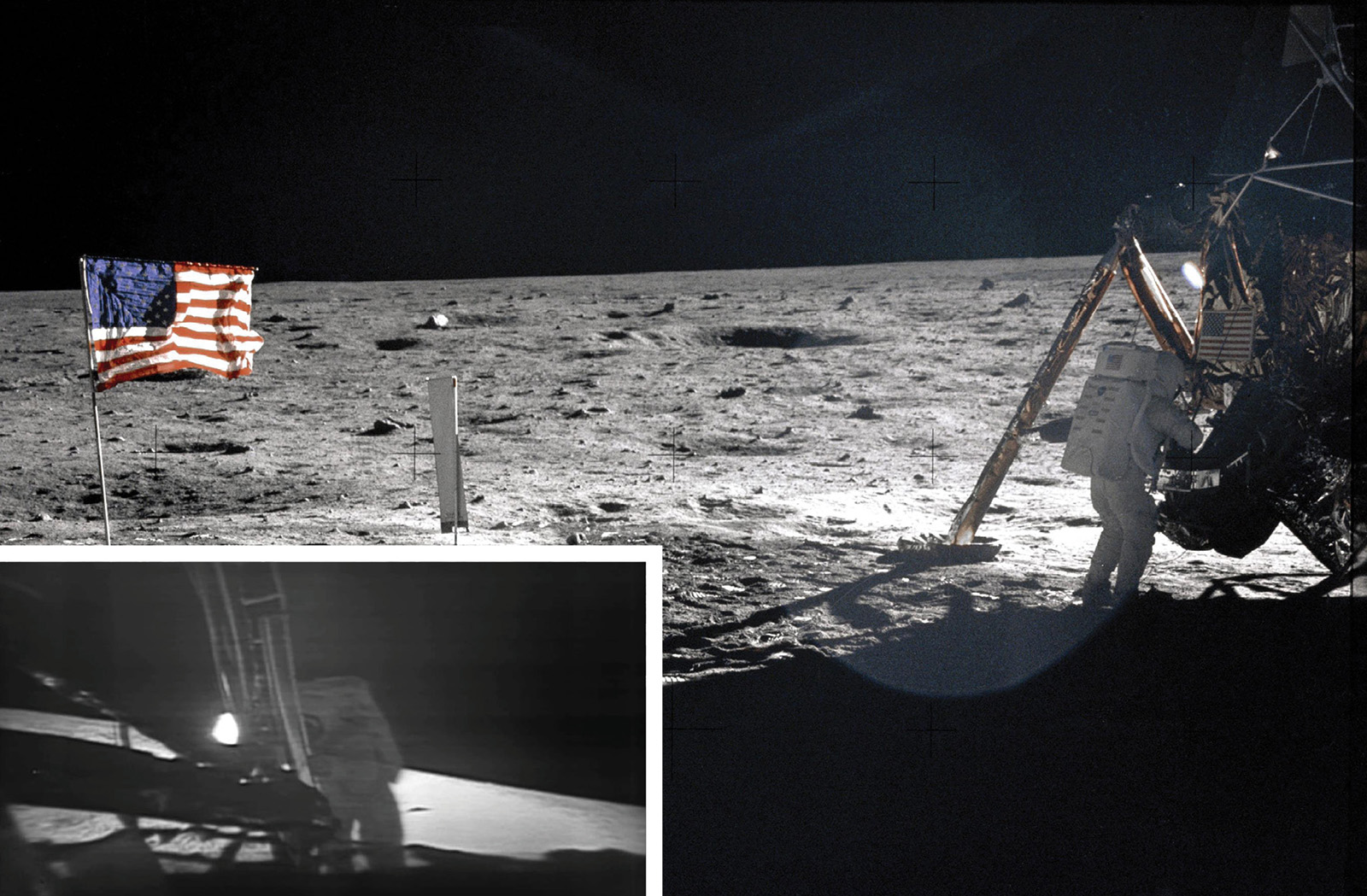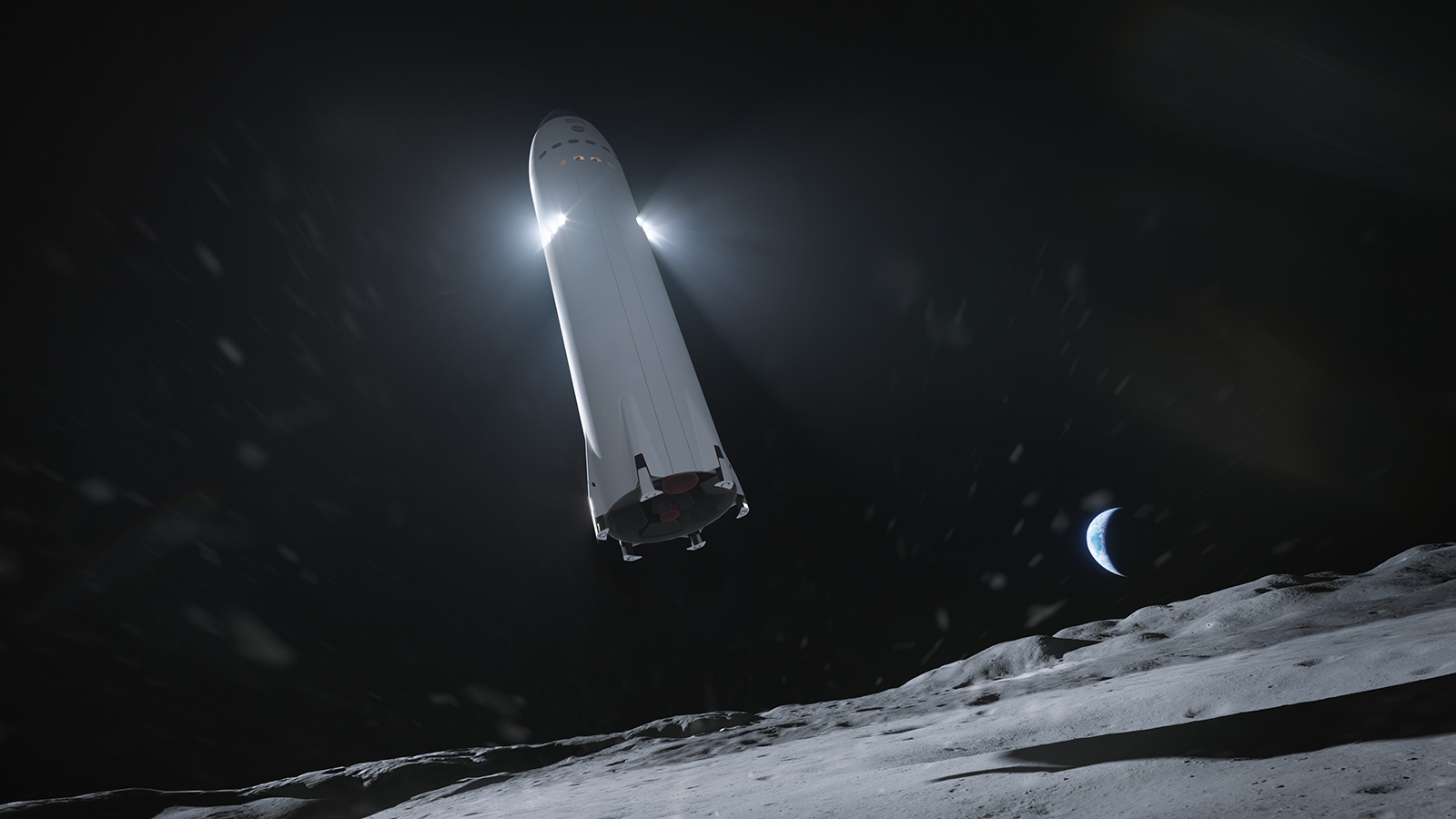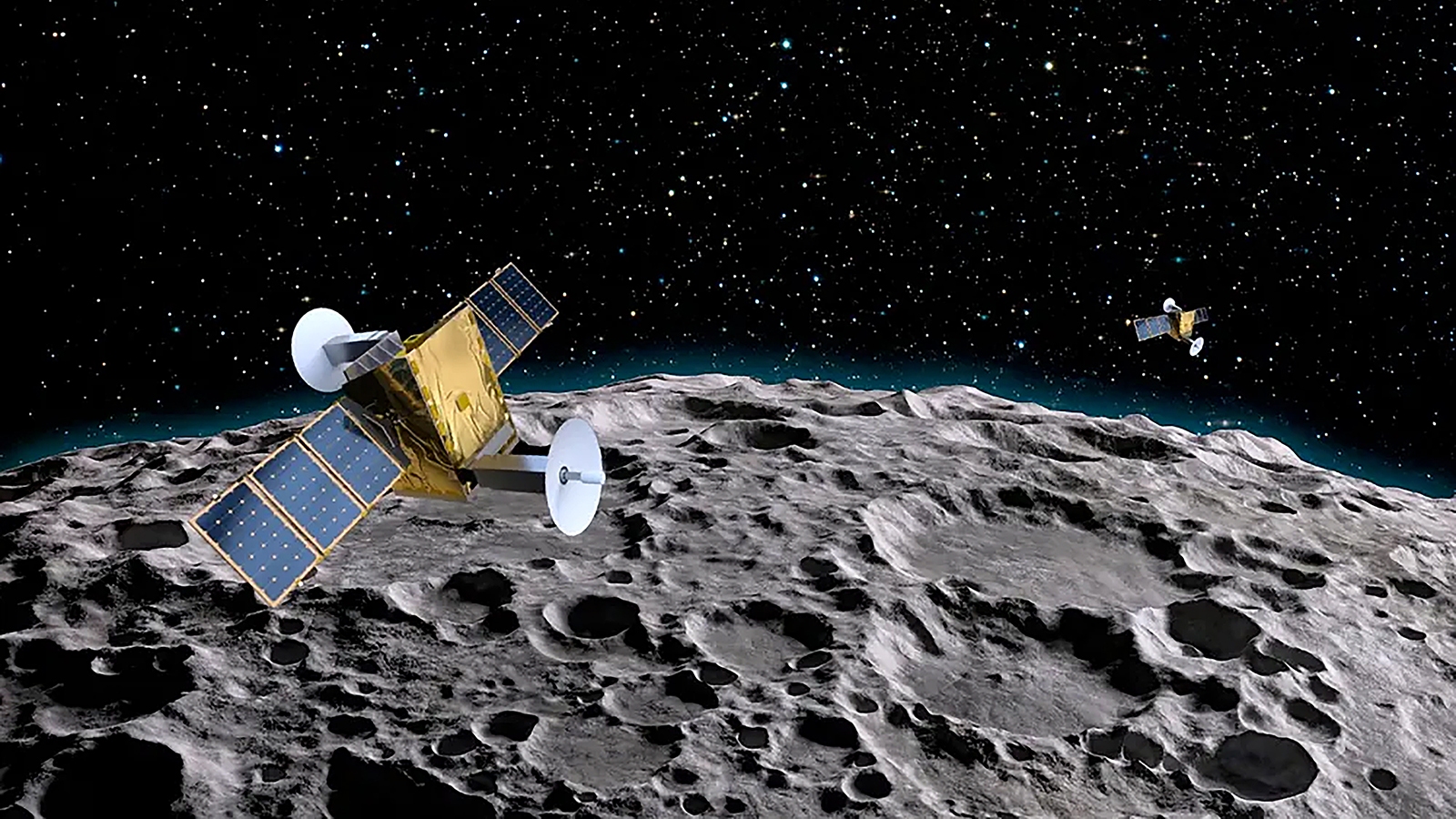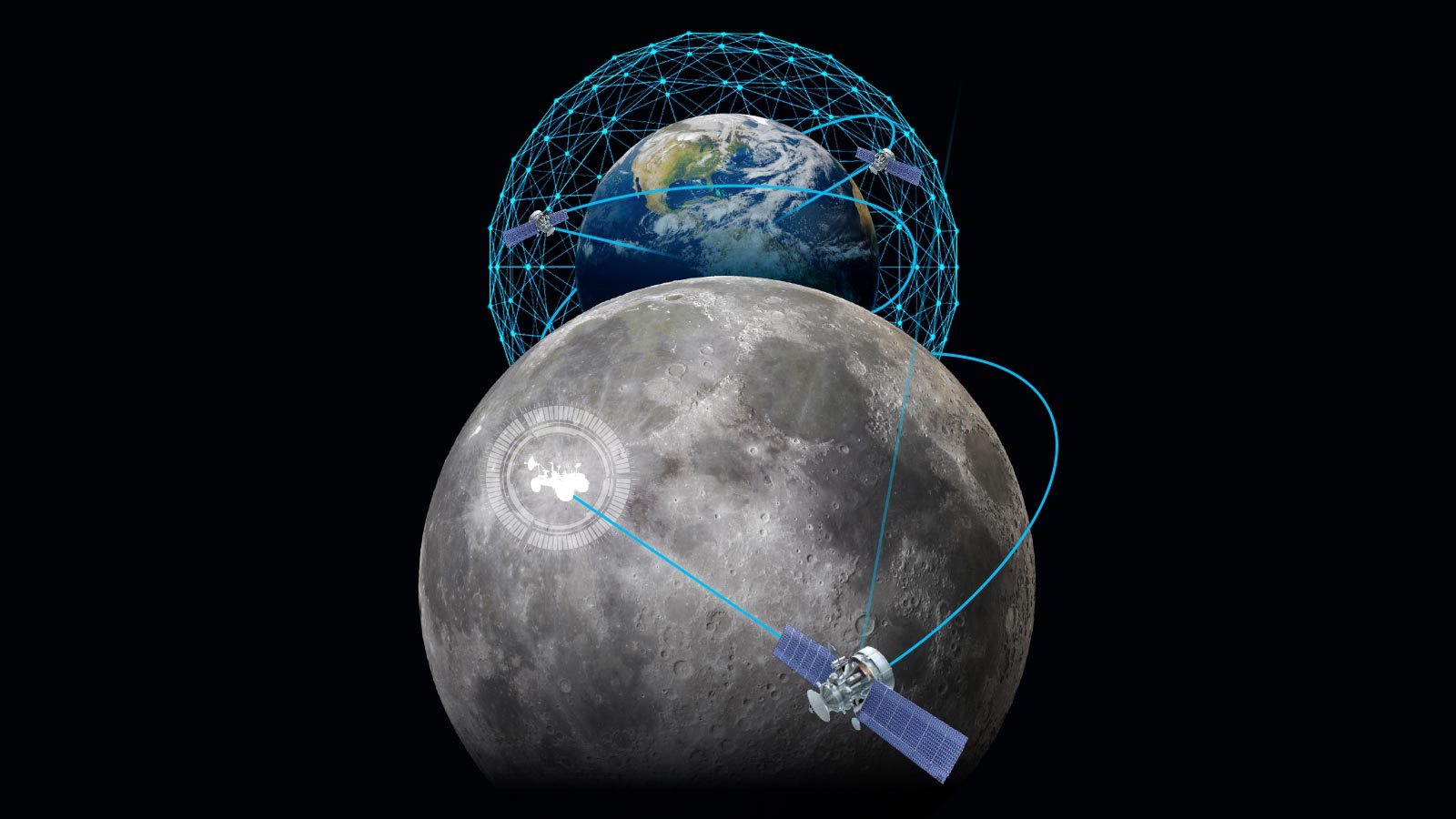Stay Up to Date
Submit your email address to receive the latest industry and Aerospace America news.
NASA will soon pick a pool of vendors to help it achieve an ambitious plan: Delivering high-definition video of astronauts on the moon to the public and a torrent of scientific information to scientists. Jon Kelvey tells the story.
Under NASA’s Artemis program, astronauts will be landing on the moon in a succession of missions into the 2030s to explore deep craters hidden permanently by shadows, learn how to make rocket fuel from lunar ice and eventually set up one or more permanent base camps at the south pole. These human missions, especially the first ones, are likely to enthrall the public, but the bigger purpose of Artemis is provide scientists with details of the moon’s composition, temperature, radiation levels, tectonic history and a host of factors. This data could help NASA, its international partners and the private sector permanently settle the moon and exploit its natural resources. The astronauts won’t be working alone on that but as a team with robotic landers, rovers and orbiters.
This coming epoch of cislunar learning will create an unprecedented demand for bandwidth in both directions that would overwhelm NASA’s existing communications infrastructure.
To avoid that, NASA plans to give companies specializing in space communications a greater role in its Near Space Network, or NSN, a name the agency came up with in 2020 for some of its existing communications satellites and ground antennas. NASA says by 2030, it wants to largely rely on “industry-provided communications for missions close to Earth,” meaning out to about 2 million kilometers, or five times farther than the moon but way short of Mars.
To get going on this commercialization initiative, NASA in July or August plans to select multiple companies to augment the network and provide tracking, navigation and communications services through it. This strategy will reduce costs and increase network “responsiveness and availability” by establishing “an abundance of service providers,” NASA predicted in 2020 when it initiated the effort.
The hunt for more bandwidth
NSN works today, but not as well as NASA would like. During the 2022 uncrewed Artemis I loop around the moon, NASA stayed in contact with the Orion spacecraft by combining the bandwidth of NSN with that of the Deep Space Network, the antenna sites in three nations that more typically link NASA to its most distant spacecraft. The year before, those expecting to be visually wowed by the 2021 Inspiration4 mission, the first launch of a spacecraft with an all-private crew aboard, were disappointed.
“The public, or at least the space community, was questioning why we weren’t getting immediate feedback from the Inspiration4 crew — the livestreams we expect,” says Laura Forczyk, a space industry analyst and founder of the consulting firm Astralytical. “Well, it was a communication, bandwidth issue.”
SpaceX livestreamed the launch of the four passengers in a Crew Dragon capsule, but footage of them in space had to wait for the release of the final episode of a Netflix documentary, she notes. NASA and the International Space Station had priority access to the limited amount of bandwidth for communicating between Earth and low-Earth orbit.

NASA’s public affairs office declined to make anyone available to be interviewed for this article, saying it’s in a blackout period ahead of the NSN selections. NASA did tell us it plans to maintain ownership of NSN, and in a letter to the competitors, it underscored that selectees must “meet the specific technical acceptability standards” set by NASA. The selected vendors will be eligible to compete for various “task orders” over a period of 10 years.
The task order strategy of creating a pool of vendors, if indeed that’s NASA’s plan for NSN, has become a theme for the agency. In hopes of getting multiple robotic spacecraft to the surface of the moon quickly, NASA in 2018 selected nine companies, and four more in 2019, to compete for task orders to build and land robotic spacecraft on the moon under the Commercial Lunar Payload Services program. To date, NASA has awarded eight task orders with a combined value of $2.6 billion. In another example, NASA in June 2022 selected Axiom Space and Collins Aerospace as the winning bidders in its Exploration Extravehicular Activity Services competition to develop next-generation spacesuits. That September, Axiom was awarded a $228.5 million task order to build the spacesuits for the Artemis III lunar landing, and Collins Aerospace in December won a $97.2 million task order to build new spacesuits for ISS.
In the case of NSN, the request for proposals invited companies to propose how they would build commercial infrastructure to improve and expand NSN operations, and then sell NASA and other customers high bandwidth, secure communications and navigations services.
The speed of need
Can any of this be ready in time for the historic Artemis III return to the moon by U.S. astronauts? Right now, that landing is scheduled for December 2025. It’s unclear which, if any, of the NSN upgrades would be in place by then. A slide from the second industry day says NASA could begin “on-orbit testing” in 2025; “on-orbit service verification” in 2027; and “on-orbit validation” in 2028. That would seem to rule out an augmented NSN being ready for Artemis III, but NASA in June said that mission is likely to slip to 2026.
Forczyk sees evidence that a delay is almost certain. NASA needs a variant of SpaceX’s Starship upper stage to carry two astronauts from an Orion spacecraft in lunar orbit to the surface of the moon and back. Before that can happen, SpaceX must show that Starship can reach space in one piece, and then demonstrate fueling it in low-Earth orbit from a yet-to-be-built propellant depot for the journey to Orion. And then, in an uncrewed test mission, SpaceX must land a Starship on the moon. That’s why April’s failure to reach space has injected uncertainty into the Artemis plan. [See feature, “Fixing Starship.”]
It’s possible that the Artemis schedule might slip in just the right way as to align with new NSN services, perhaps even optical communications, coming online. But should the Artemis and NSN schedules hold, then 2028 would be just in time for the Artemis IV mission, currently planned for sometime that year.
What history tells us
For those who remember the 1969 moon landing, or who are students of it, it turns out that the state of space technology in 1969 was not the only hurdle to better video. The grainy, washed out black-and-white scenes that the global television audience of 500 million watched were that way partly because of factors here on Earth.
“The cleanup of some old tapes that have been found showed the actual [image] quality from the moon was better than what we got on the TV,” says historian Michael Neufeld of the Smithsonian’s National Air and Space Museum in Washington, D.C. “The translation of the signal and conversion into regular television standard meant that it was degraded.”
This signal was carried back to Earth through what would become the Deep Space Network: at the time, three stations of dish radio antennas that the Jet Propulsion Laboratory constructed in the late 1950s for communicating with the Pioneer and Ranger probes to the moon.
“You need three stations basically, spaced roughly 120 degrees apart around the globe,” Neufeld says, “so that the moon is up at least in one of those three stations.”
After the last Apollo mission in 1972, NASA shifted the Deep Space Network to cover robotic missions into deep space. Human spaceflight was confined to low-Earth orbit, first with the Skylab missions from 1973 into 1974 and then with the famous Apollo-Soyuz mission in 1975 in which astronauts and cosmonauts shook hands through their docked vehicles. Subsequently, the shuttle program and ISS kept generations of NASA astronauts in low-Earth orbit.
Starting in 1983, communications for human spaceflight were routed through NASA’s geostationary Tracking Data and Relay Satellites, TDRS, the first of which was carried into space on the first flight of the space shuttle Challenger. But now that astronauts are heading beyond low-Earth orbit again, “Artemis creates the same problem that Apollo did: You launch out to the moon and pretty soon — in fact, within the first hour or two of launch — you’re passing geostationary altitude,” Neufeld says, meaning out of range of TDRS.
The Deep Space Network could fill the void, but its responsibilities have grown dramatically since the days of Apollo, servicing NASA’s Mars rovers and probes studying the sun and outer planets, as well as international missions.
“Every single interplanetary spacecraft is communicating to Earth, pretty much, through the Deep Space Network,” says Glenn Lightsey, a professor of space systems technology at Georgia Tech. “It’s capacity limited. It really cannot handle hundreds of users and lots of high data rates, and so there needs to be an augmentation or an alternate service to the Deep Space Network.”
That’s where NSN comes in. Today’s NSN consists of 17 commercial and government-owned radio antennas and radar installations stretching around the globe, along with the TDRS constellation. When communicating directly to Earth, NSN can return data at a rate of 3.5 gigabits per second, close to the rate required for high-definition Netflix.

While the Deep Space Network exclusively links spacecraft including the James Webb Space Telescope and Chandra X-Ray Observatory to Earth, the NSN is the sole network for missions taking place from the upper atmosphere to beyond the moon. That includes, for example, the Super-pressure Balloon-borne Imaging Telescope, an astronomy telescope on a high-altitude balloon that’s circumnavigated the southern hemisphere multiple times since it was launched in April. NSN also relays communications to and from the Pentagon’s STPSat-6, one of its Space Test Program satellites, which carries a nuclear detonation detection payload and an experimental infrared laser communications device for NASA.
Near Space Network 2.0
The request for proposals asks bidders to define how to carry both direct-to-Earth and space relay communications across three regions:
- Earth proximity, which runs from the Earth’s surface to geosynchronous orbit at around 36,000 kilometers
- GEO to cislunar, altitudes from geosynchronous orbit out to 500,000 kilometers altitude
- xCislunar, for altitudes from 500,000 kilometers out to 2 million kilometers from Earth, a reach that includes the L1 and L2 sun-Earth Lagrange points
The proposals will have to cover the same frequency bands the NSN currently covers but may also include optical laser communications at the 1,530 to 1,565 nanometer wavelengths. Commercial providers will also have to show their systems can return direct-to-Earth data with no more than 15 seconds of latency.
Reactions to the RFP have been somewhat mixed. Lockheed Martin in March created Crescent Space, a subsidiary that has submitted a bid for the NSN competition. Crescent is developing a system it calls Parsec, consisting of two satellites that will orbit the moon to pick up signals from the lunar surface and the surrounding space and then relay them back to a commercial vendor’s radio antenna on Earth. Parsec will use radio frequency communications rather than optical and, regardless of whether it wins the NASA contract, aims to begin offering commercial services to customers in 2025.
“We are excited about NASA’s NSN program, and it’s a huge opportunity, but we’ve already started the development of Parsec. We’re not waiting,” Crescent Space CEO Joe Landon says, noting that while NASA is a major player in the space communications market, it’s not the only one. “We’re basing this business on the market that we expect to develop.”

Italian aerospace company Argotec, which is not an NSN competitor, has been working on a separate lunar communications concept that sounds similar to Parsec. Dubbed Andromeda, the constellation would consist of 24 satellites divided into four orbits around the moon, with six satellites per orbit. In a commentary published in IEEE Spectrum, the head of Argotec’s research and development unit, Alessandro Balossino, described the company’s end goal as providing 5G broadband coverage of the entire moon. NASA’s RFP does not address wireless coverage on the moon, but in 2020, NASA awarded Nokia $14.1 million to develop 4G broadband connectivity for the moon.
Hard questions
Forczyk can’t resist looking in the rearview mirror for a moment.
“Why is this now finally happening versus a decade ago when we all saw that it needed to happen?” she says. “Or at the beginning of the Artemis program kickoff, when everybody had the momentum of ‘This is going to happen’?”
Vincent Chan is another expert with some questions. The professor of electrical engineering and computer science at MIT questions whether radio frequency communications will cut it, given the scope of NASA’s Artemis ambitions, which include multiple missions to the lunar south pole, along with lunar rover and science missions through commercial partners. IBM suggests that on Earth, a 4K resolution high-definition video stream requires 8 to 14 gigabits per second. HD 1080 resolution meanwhile, the high-definition format available to standard-tier Netflix subscribers, requires a bitrate of 4 to 8 gigabits per second.
In April, NASA’s Pathfinder Technology Demonstrator 3 used optical communications technology that Chan helped develop at MIT’s Lincoln Laboratory to transmit more than 3 terabytes of data — the equivalent of hundreds of hours of high-definition video — from orbit to Earth at 200 gigabits per second. But that’s laser communications. Chan says relying on radio waves to carry sensor and instrument data, as well as video feeds, will greatly increase the cost of the commercial NSN.
“If you use radio frequency, the biggest problem is that you need a big honking transmitter because the divergence of the beam is proportional to the wavelength,” he says, with microwave beams being about 100 times as wide as a 1.5-micron laser beam. Transmitting lots of data through radio, therefore, requires a lot more power and bigger, more costly satellites.
“If you say they’re using RF, I think they’re going to fail,” Chan says. “They may not fail in a 1-megabit to 10-megabit [region], but they’re certainly going to fail in the gigabit region.”
Robert Brumley, the founder and chairman of CommStar Space Communications, shares Chan’s skepticism about whether a purely radio frequency NSN can achieve NASA’s Artemis goals. And from his reading of the RFP, he doesn’t believe NASA would be ready to integrate any optical communications into NSN until at least 2027 — too late for Artemis III at least, if the current schedule holds.
“It is a disappointing outcome if optical is not brought forward as a service sooner. We all know RF spectrum is scarce, even in cislunar, and data delivery — especially content like streaming video — requires high capacity throughput,” Brumley says. “The result would be, if no optical when the Artemis III crew gets to Shackleton Crater, no Netflix. It is not too late for NASA to clarify its position.”
NASA did not respond to requests for clarification about optical communications in the RFP, which merely notes the frequency band for optical communications is 1,530 to 1,565 nanometers. A NASA brochure explaining the NSN’s current capabilities describes optical communications as “demonstration only.”
But NASA might simply be acting pragmatically, according to Advanced Space CEO Bradley Cheetham. While he acknowledges that the proliferation of instruments producing lots of data on future lunar missions will require much more bandwidth than is available today, he also notes that getting an optical communications system working around the moon will not be easy.
“Just by the projections of demand, we’re going to need a higher data rate than we can probably support using X-band, S-band, Ka-band radio frequencies,” Cheetham says. So while optical communications are part of future solutions, “moving it from where we are today, with very limited adoption in deep space to the only option in deep space, I think introduces a lot of operational problems for missions that are trying to fly.”
Cheetham notes that when Advanced Space lost contact and control of its CAPSTONE spacecraft while it was on its way to the moon last July, for instance, the team never could have reestablished contact using optical communications, since they require a narrow laser beam to maintain pinpoint focus on a receiver. The team regained control of CAPSTONE in October.
“On CAPSTONE, as we were spinning out of control in deep space, we needed a wide beam width, low-power RF signal to be able to talk to the satellite,” Cheetham says. “If that was a laser spinning around, we never would have been able to hear from it.”
Even if NASA were ready to integrate laser communications technology for the NSN and awarded a contract tomorrow, it would take time to build and test the new commercialized network. Even though most of the technology already exists, the Georgia Tech professor Lightsey says, it still takes time to build out new ground-to-space infrastructure.
“I think the idea of getting something up and running within five years is pretty achievable,” he says. “It would take that long anyway, just because of the logistics of getting a system like that in space.”
And then again, schedules could slip, with NSN development lagging far behind human spaceflight. It is the space business, after all.
“We always expect things to be faster and work on the first time, but it never does,” Forczyk says. “It’s always more complex, more expensive, slower.”
About jon kelvey
Jon previously covered space for The Independent in the U.K. His work has appeared in Air and Space Smithsonian, Slate and the Washington Post. He is based in Maryland.
Related Posts
Stay Up to Date
Submit your email address to receive the latest industry and Aerospace America news.




